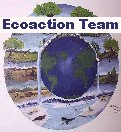
Course: Environmental Earth Science Date: 10/11/07
|
|
November |
December |
|
Section: Essential Questions: |
Atmospheric Physics |
||
|
Concepts: Essential Questions: |
Energy Distribution |
Weather Data |
Weather Systems |
|
Content What will students know? |
Energy Transfer and Transformations – What is the role of energy in our world? 9.1 - Energy cannot be created or destroyed; however, energy can be converted from one form to another. Energy enters the Earth system primarily as solar radiation, is captured by materials and photosynthetic processes, and eventually is transformed into heat. Topics: Temperature, Heat, Heat Transfer, Sun Angle and seasons, Energy Transfer in the Atmosphere, Transfer of Energy by Water (Latent Heat), Dewpoint and Relative Humidity, Phase Changes and Heat Density Changes, Air Pressure |
Pressure,
Temp., and Altitude |
Air Masses Intro to Fronts Severe weather: tornados and lightning Hurricanes 1 Hurricanes 2 |
|
Performance Expectations |
D 1. Describe the effects of adding energy to matter in terms of the
motion of atoms and molecules, and the resulting phase changes. D 2. Explain how energy is transferred by conduction, convection and radiation. D 3. Describe energy transformations among heat, light, electricity and motion. |
D 20. Explain how solar energy causes water to cycle through the major earth reservoirs. | |

Course: Environmental Earth Science
|
|
January |
February |
|
Section: Essential Question: |
Atmospheric Chemistry |
|
Concepts: Essential Questions: |
Atmosphere Composition |
|
Content What will students know? |
Topics: Intro to Atmospheric Chemistry , The Periodic Table, Molecular Bonding, Air Molecules, Atmosphere Evolution, Oh Two and You, Ozone/ chlorofluorocarbons, Intro to Climate Change, Carbon Cycle Greenhouse Gases, Particulates and Aerosols, Acid Rain, Smog and surface ozone. |
|
Performance Expectations |
Section Performance Objectives can be found at: http://www.eescilsm.org/final.cfm?startdate=39475&endate=39504&per=Per4&extra=Air%20Chem%20Test%20Objectives&skip=19.0
|


